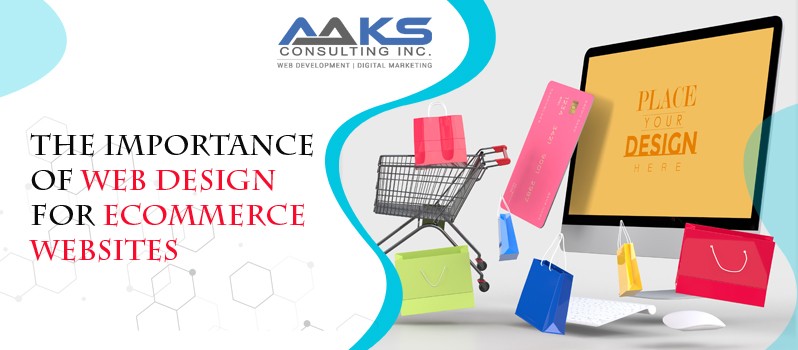The Importance Of Web Design For Ecommerce Websites
Web design is becoming more and more important for eCommerce websites, because with so many options available, customers are looking for something special to set your website apart from the rest. What are some things you can do in order to give your site a unique selling point?
What is a Web Design?
Web design for ecommerce websites is the process of creating a visually appealing, interactive website. By following specific design guidelines and principles, a web designer can create a website that is both functional and appealing to the eye. In addition, effective web design for ecommerce websites can help drive online traffic to your business.
Web design can be broken down into three main categories: front-end design, back-end design, and web development. Front-end design focuses on the look and feel of a website, while back-end design deals with how the website functions. Web development is responsible for creating the actual website codebase and ensuring that it functions properly.
There are many factors to consider when doing a web design for ecommerce websites, including user experience, site architecture, branding, and layout. User experience refers to how easy it is for visitors to navigate through the site and find what they need. Site architecture considers how the various components of the site are linked together, while branding and layout concern the overall look and feel of the site.
Effective web design requires a combination of artistic talent and technical knowledge. A good web designer will have strong visual skills as well as knowledge of HTML, CSS, JavaScript, and AJAX. Additionally, good web design requires knowledge of usability and accessibility, as well as a willingness to communicate with clients. In order to learn web design for ecommerce websites, you should find a graphic designer who specializes in the subject. Typically, this will be a person who has been designing websites for years. Ask around for recommendations, and check out the websites of local companies. Web design is an ever-changing field, and there are many different ways to approach it. This is one instance where asking for more information may give you additional insight about what exactly you want from your website. Choose the best way to learn by researching schools that offer classes on web design online or enrolling in a course offered at a community college. Most importantly, choose school options that fit with your schedule.
Types of Ecommerce Websites
There are many types of ecommerce websites, but all of them need a well-designed web design. This includes both the front-end and back-end design. Here are some tips on how to create a successful ecommerce website:
1. Choose the Right Domain name
The first step in designing an ecommerce website is choosing the right domain name. A good domain name should be catchy and memorable, and it should also be relevant to your niche market. For example, if you sell clothes, your domain name might be “clothesstore.com.”
2. Choose a Template or Design Style
Once you have chosen the right domain name, the next step is to choose a template or design style. There are many different templates and design styles available on the web, so it’s important to find one that suits your business and creative vision. Some popular options include minimalistic designs and flat web designs.
3. Choose a Web Hosting Provider
Once you have chosen a template or design style, it’s time to choose a web hosting provider. Web hosts provide the space on their servers for your website, as well as bandwidth and other services required for online business operations. It’s not necessary for you to have a web hosting plan in place when you register your domain name, but it’s definitely a good idea if you want to maintain the website and increase traffic. A few things to note:
• Web hosts are available in different price ranges, with some costing very little while others cost thousands of dollars. You’ll need to research the features offered by each host before deciding on one, including their customer service and technical support policies.
• The number of websites hosted on each account can vary greatly, so it’s important to check out different hosting providers’ monthly quotas and pricing plans before selecting one that suits your business needs.
• There are free web hosts available, but they come with limited capacity and bandwidth . These free web hosts offer limited storage and bandwidth, so you’ll have to upgrade to a paid hosting plan if your business needs more memory or bandwidth.
• You’ll need an e-mail address to register with a web host, and you may also need one for your domain name as well. Many providers will provide both e-mail accounts as well as domain names for free. There are certain restrictions you’ll need to follow when registering each of these accounts, but this is generally just being sure that all of the necessary information is up to date and correct before setting up your website.
• The amount of disk (hard disk) space available on each account can vary greatly depending on which type of hosting plan you select. It’s important to research the amount of space you’ll need to work with before you begin. Each hosting plan has a recommended limit for file size that each folder can hold, and when this size is reached, the content will be deleted on your site.
• On some plans, you may be able to have multiple FTP accounts (or directories) for different purposes. For instance, one may be for sites like yours that are going to be updated regularly; another might be for just a few small sites you’re building for specific clients. Several hosting companies even offer space in their own data centers where all of these areas can share bandwidth and resources in order to save money on maintenance fees as well as maximize space savings on the main server’s hard drive.
• All hosting plans come with a free domain name, which is the web address of your website (like www.yourdomain.com). You may want to use this as an email address as well, or even to get a personalized URL like [email protected]
.• SSH access gives you the ability to connect to a computer’s terminal and type commands into it through a secure channel between two computers that can’t be eavesdropped on by someone outside. This gives you far more power than regular FTP and several hosting companies provide SSH access for only extra cost—a definite plus for sites that will see heavy traffic! (You can find out if your host offers SSH access at www.sshfs.org.)
• Although not all hosting companies support it, it seems to me that the more advanced ones do. It’s called IIS or Web Server, and it lets you install ASP, PHP, and other server-side programs on your site without having to have a developer do it for you. It also allows you to install extra tools like RSS feeds and database applications—things you’d probably only use occasionally, if at all. Most of the hosting companies I checked out let you choose between CGI or Fast CGI scripts:
• CGI (Common Gateway Interface) is what most people think of when speaking about server-side programming; it’s an Application Programming Interface that can be used by any web page but is restricted to receiving a specific kind of data (and in certain cases, sending data).
Common Features of Successful Ecommerce Websites
Web design is an important part of any ecommerce website. A well-designed website will attract more customers, increase conversion rates and improve SEO. Here are five common features of successful ecommerce websites:
1. Ecommerce websites should have a clear and easy to use layout.
2. Navigation should be easy to find and use, with buttons and icons organized in a logical way.
3. Graphics should be professional and eye-catching, without being too flashy or over the top.
4. Prices and inventory should be easily searchable, so customers can find what they’re looking for quickly.
5. The website should be optimized for mobile devices, so users can shop from anywhere.
Why Does Web Design Matter for Ecommerce Sites?
Web design is important for online retailers because it helps to create a visually appealing and user-friendly experience for customers. Poor web design can lead to frustration, wasted time and money, and lost sales. In fact, according to a study by research firm Nielsen, 94% of shoppers abandon an online purchase if the site is difficult to use.
A well-designed ecommerce website will feature intuitive navigation, well-organized product listings, and attractive fonts and graphics. It should also be easy to find the information you’re looking for, and the layout should be consistent across all pages. Furthermore, a good web design will help your business stand out from the competition.
There are a number of factors to consider when designing a web page for an ecommerce site, including:
Layout: The layout of your website should be user-friendly and organized. You want your pages to flow intelligently from one section to another, and you should avoid overcrowding or confusing designs.
The layout of your website should be user-friendly and organized. You want your pages to flow intelligently from one section to another, and you should avoid overcrowding or confusing designs. Navigation: Your website’s navigation system should be easy to follow and navigate. Make sure it is intuitive and well labeled, so that even the weakest of users will be able to find what they’re looking for. Your website’s navigation system should be easy to follow and navigate. Make sure it is intuitive and well labeled,
so that even the weakest of users will be able to find what they’re looking for. Search features: Keep your search box at the top of every page of your site; SEO experts suggest you keep it as prominent as possible. Many people don’t realize how important this feature can be when determining search engine rankings, but it can also make your customers feel more comfortable using your website. Keep your search box at the top of every page of your site; SEO experts suggest you keep it as prominent as possible. Many people don’t realize how important this feature can be when determining search engine rankings, but it can also make your customers feel more comfortable using your website.
6 Award-Winning Blogs to Inspire You (CLICK) 6 Award-Winning Blogs to Inspire You Award-winning blogs serve a huge purpose in the world of blogging—they inspire you and other bloggers on the web with their positive stories, exceptional knowledge and writing skills, brilliant examples of effective content marketing, and unique thoughts on topics that are important to readers. Thank goodness for award-winning blogs! Without them as sources for inspiration, many bloggers would have never fully realized their goals of becoming highly successful at blogging. Check out these 6 award-winning blogs that I have handpicked:
1. Rosalind Wiseman The founder of Oh Happy Day, Rosalind Wiseman has won several blogging awards including the BlogBabe Award for Best Use of Social Media and Best Post about a Blogger.
2. Katharine Hayhoe Katharine Hayhoe, climate scientist with Texas Tech University, who recently made headlines when she was featured on CNN’s “The Ridiculist” after a blog post of hers went viral and became an instant meme.
3. Chelsea Clarke Chelsea Clarke is the co-founder of Chellie Good, a blog dedicated to helping women improve their careers by providing them with tips and inspiration to take their careers further and faster than they would have been able to do otherwise.
4. Chris Guillebeau Chris Guillebeau, author of “The $100 Startup,” has sold his book in more than 45 countries across 6 continents. He has also earned favorable mentions and interviews from the news media including The New York Times, Business Insider, TechCrunch and Washington Post.
5. Tami Akbar Tami Akbar is a blogger who runs the blog Step-by-Step Mom. Her posts include recipes and advice on parenting, family life, finances and relationships for girls ages four to 12 years old. Tami calls herself a “lifestyle blogger who shares her life with her readers” and for good reason: She has become one of the most popular Pinterest users behind other popular users like Jessica Alba and Martha Stewart. She’s also the author of two books: “One Mom’s Battle to Save Her Children from the Dangers of Television” and “Big Life Lessons for Little Girls.”
6. Perpetual Kid Perpetual Kid is a clothing company that offers high-quality, affordable clothing with one simple goal: to make clothes that kids love to wear. Founder Jeff Rense, who has a 13-year-old daughter, became frustrated when he noticed girls dressing in boring shades of pink and blue while boys were wearing colorful designs but paying higher prices. He believes girls should be free to express themselves through their style choices and boys should be allowed to show off their individuality. He started the business with a $1,000 loan from his mother and has since raised more than $6 million in funding.
7. Project Handclasp Project Handclasp is an organization that helps provide clean water to children in developing countries by training local mothers how to build and operate simple hand pumps. The organization also provides them with tools so they can take their pumps home and continue pumping water on their own after the initial training session. Currently, there are over 500 women worldwide who have successfully pumped water on their own since receiving the initial training sessions from Project Handclasp.
8. RiceTalks Foundation RiceTalks is an organization that provides bed nets for preventable malaria deaths among children in the third world. The nets are donated to organizations in Kenya and India, which then distribute them to their communities at hospitals and schools where they can be distributed after pregnancy and childhood. Since 2012, RiceTalks has helped prevent over 16,000 deaths from malaria worldwide.
Conclusion
It’s very important hire a web designer for ecommerce websites, and it can play a big role in increasing traffic and conversion rates. If your website isn’t designed well, potential customers may not be attracted to it or they may decide not to buy anything from it. A poorly designed website can also lead to frustration on the part of visitors, which can ultimately impact your business negatively. So if you want your ecommerce business to thrive, make sure to invest in a quality web design scheme that will help you reach your goals.




